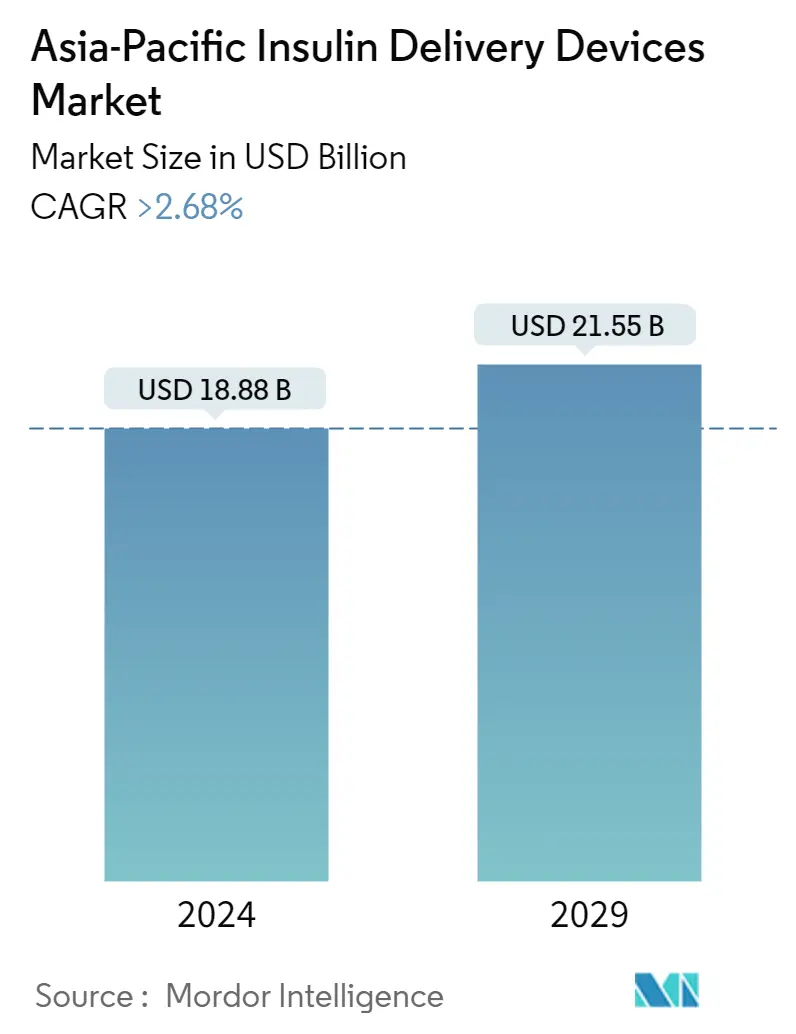Market Size of Asia-Pacific Insulin Delivery Devices Industry

| Study Period | 2018 - 2029 |
| Base Year For Estimation | 2023 |
| Forecast Data Period | 2024 - 2029 |
| Market Size (2024) | USD 18.88 Billion |
| Market Size (2029) | USD 21.55 Billion |
| CAGR (2024 - 2029) | 2.68 % |
Major Players
*Disclaimer: Major Players sorted in no particular order |
Asia-Pacific Insulin Delivery Devices Market Analysis
The Asia-Pacific Insulin Delivery Devices Market size is estimated at USD 18.88 billion in 2024, and is expected to reach USD 21.55 billion by 2029, growing at a CAGR of greater than 2.68% during the forecast period (2024-2029).
The occurrence of newly detected cases of Type 1 and Type 2 diabetes is observed to be on the rise, primarily attributed to factors such as obesity, unhealthy eating habits, and lack of physical activity.
The escalating number of individuals diagnosed with diabetes and the subsequent increase in healthcare expenses in developed nations serve as clear indicators of the growing utilization of diabetic care products. Furthermore, the market growth is propelled by the surging adoption of insulin-delivery devices and the expanding prevalence of diabetes. Prominent manufacturers are directing their efforts towards technological advancements and the creation of cutting-edge products in order to secure a significant market share.
According to the International Diabetes Federation (IDF), the IDF South-East Asia (SEA) Region is home to 90 million adults (aged 20-79) living with diabetes in 2021. This number is projected to rise to 152 million by 2045. In the IDF Western Pacific Region, there are currently 206 million adults (aged 20-79) living with diabetes in 2021, and this is expected to increase to 260 million by 2045.
The primary cause of diabetes is the imbalance in blood glucose levels, which deviate from the standard levels. Physicians can diagnose the disease through general lab diagnostic tests. However, individuals with greater fluctuations in glucose levels should monitor their levels daily. Those who require insulin must frequently check their blood glucose levels, adjust insulin doses, or consider changing their medication if necessary.
The Asia-Pacific region has witnessed an astounding increase in the prevalence of diabetes in patients, in recent years. The increasing demand for insulin has led to great R&D in manufacturing different, painless types of insulin deliverable devices, like CGM-integrated insulin pumps. Traditionally, insulin syringes were the only form of insulin delivery system, which were considered to be painful and not user-friendly. Furthermore, the dosage may not be accurate. Thus, companies, like Novo Nordisk and Sanofi, among others, have bought their insulin pens in the market. These pens have a specific set of dosages and are considered to be not only less painful to use, but also reduce wastage of insulin. The high cost of insulin pens is the only prominent restraining factor for the growth of the pens market.
Asia-Pacific Insulin Delivery Devices Industry Segmentation
Insulin injections under the skin are the most popular method of administering insulin. Insulin can be administered subcutaneously using various devices, including insulin pens, pumps, vials, and syringes. The study provides a detailed analysis of the insulin delivery devices market in the Asia-Pacific region and includes market share, size, forecast, and industry overview. Asia-Pacific Insulin Delivery Devices Market is segmented by devices (Insulin Pens (cartridges in reusable insulin pens, and disposable insulin pens), insulin syringes, insulin jet injectors, insulin pumps (Technology ( Tethered Insulin Pump, Tubeless Insulin Pump) and by Components (insulin pump device, insulin pump reservoir, and infusion set). The report offers the value (in USD) and volume (in units) for the above segments. We will provide a segment-wise breakdown (value and volume) for all the countries covered under the Table of Contents.
| Device | |||||||||||
| |||||||||||
| |||||||||||
| Insulin Syringes | |||||||||||
| Insulin Jet Injectors |
| Geography | |
| Australia | |
| India | |
| Indonesia | |
| Thailand | |
| Philippines | |
| Vietnam | |
| China | |
| South Korea | |
| Japan | |
| Malaysia | |
| Rest of Asia-Pacific |
Asia-Pacific Insulin Delivery Devices Market Size Summary
The Asia-Pacific insulin delivery devices market is experiencing significant growth, driven by the increasing prevalence of diabetes in the region. Factors such as obesity, unhealthy eating habits, and sedentary lifestyles have contributed to a rise in both Type 1 and Type 2 diabetes cases. This surge in diabetes diagnoses is leading to higher healthcare expenditures and a growing demand for diabetic care products, including advanced insulin delivery devices. Prominent manufacturers are focusing on technological innovations to develop cutting-edge products, such as CGM-integrated insulin pumps and insulin pens, which offer more user-friendly and less painful alternatives to traditional syringes. Despite the high cost of these devices, their adoption is expected to drive market expansion.
Japan holds a significant share of the Asia-Pacific insulin delivery devices market, with an increasing geriatric population and changing lifestyle trends contributing to the rise in diabetes cases. The country's well-organized healthcare system, which prioritizes diabetes care and covers treatment costs, supports the market's growth. The introduction of painless insulin delivery systems, like insulin jet injectors, addresses the need for alternatives to needle-based systems, particularly for children with Type 1 diabetes. The market is characterized by a few major players holding substantial shares, while the insulin syringe segment remains fragmented with numerous local players. Collaborations and investments in research and development are key strategies for companies aiming to expand their market presence and develop innovative solutions.
Asia-Pacific Insulin Delivery Devices Market Size - Table of Contents
-
1. MARKET DYNAMICS
-
1.1 Market Overview
-
1.2 Market Drivers
-
1.3 Market Restraints
-
1.4 Porter's Five Forces Analysis
-
1.4.1 Bargaining Power of Suppliers
-
1.4.2 Bargaining Power of Consumers
-
1.4.3 Threat of New Entrants
-
1.4.4 Threat of Substitute Products and Services
-
1.4.5 Intensity of Competitive Rivalry
-
-
-
2. Market Segmentation
-
2.1 Device
-
2.1.1 Insulin Pump
-
2.1.1.1 By Technology
-
2.1.1.1.1 Tethered Insulin Pump
-
2.1.1.1.2 Tubeless Insulin Pump
-
-
2.1.1.2 By Component
-
2.1.1.2.1 Insulin Pump Device
-
2.1.1.2.2 Insulin Pump Reservoir
-
2.1.1.2.3 Infusion Set
-
-
-
2.1.2 Insulin Pens
-
2.1.2.1 Cartridges in Reusable Insulin Pens
-
2.1.2.2 Disposable Insulin Pens
-
-
2.1.3 Insulin Syringes
-
2.1.4 Insulin Jet Injectors
-
-
2.2 Geography
-
2.2.1 Australia
-
2.2.2 India
-
2.2.3 Indonesia
-
2.2.4 Thailand
-
2.2.5 Philippines
-
2.2.6 Vietnam
-
2.2.7 China
-
2.2.8 South Korea
-
2.2.9 Japan
-
2.2.10 Malaysia
-
2.2.11 Rest of Asia-Pacific
-
-
Asia-Pacific Insulin Delivery Devices Market Size FAQs
How big is the Asia-Pacific Insulin Delivery Devices Market?
The Asia-Pacific Insulin Delivery Devices Market size is expected to reach USD 18.88 billion in 2024 and grow at a CAGR of greater than 2.68% to reach USD 21.55 billion by 2029.
What is the current Asia-Pacific Insulin Delivery Devices Market size?
In 2024, the Asia-Pacific Insulin Delivery Devices Market size is expected to reach USD 18.88 billion.

